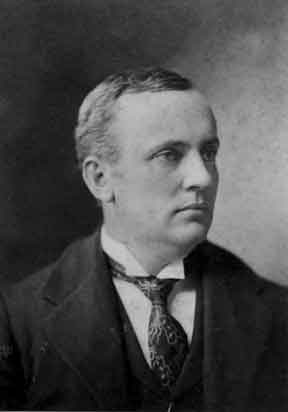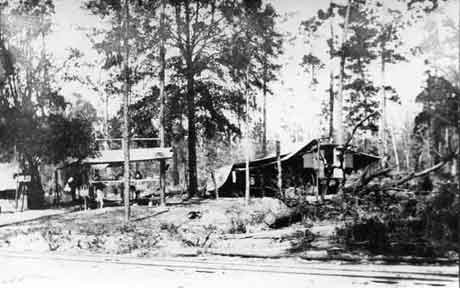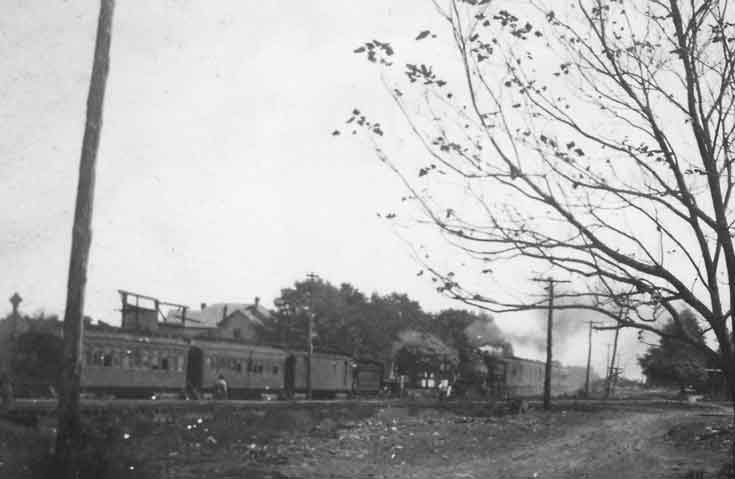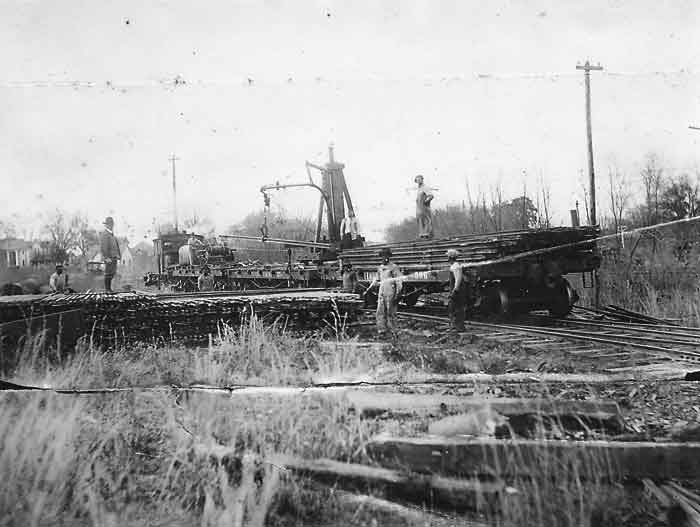

April , 2003

Part Three of Three
by Donald
R. Hensley, Jr.
All
photos from the State of
Florida Photographic Archives unless noted otherwise.
(c) 2003
Many events would shape the future of Frank Drew's Florida Railway.
First and foremost
Perry was in an area that Seaboard felt was their
exclusive territory and wanted very much to control any railroad that
entered.
It seems there was a gentlemen's agreement between the Florida Central
and
Peninsular (Seaboard) and the Plant System (Atlantic Coast Line) about
the
territory west of the Suwannee River being exclusively for the
Seaboard.
However it became clear that the Atlantic Coast Line was not interested
in old agreement made between the rival companies. When Seaboard balked
at the financing needed by the Dowling's to build to Perry and Mayo,
the
Atlantic Coast Line jumped in and advanced what ever was needed. The
Live
Oak and Perry RR was soon renamed the Live Oak Perry and Gulf and
construction
commenced from Day west towards Perry and south to Mayo and Alton. By
mid
1906 the Florida Railway was now competing against the new railroad and
later
on the Drew's Alton Mill was taken over by the Dowling's in 1910
further
eroding freight revenues. Seaboard was also hurt as all the freight the
LOP&G
carried to Live Oak went out over the Coast Line.
All this had a very real effect on the Florida Railway's freight
revenues. The Suwannee and San Pedro in 1904-05 had revenues
of 46,000 dollars and the following year the new Florida Ry increased
by 30 percent to over 60,000 dollars. But next year (1905-06) the newly
built LOP&G had already eroded the Florida Ry's freight revenue
as it was
down to 55,000 dollars. The 1906-07 season was even grimmer as freight
receipts dropped down to 43,000 dollars. The next season
(1908-09) was even worse
as freight revenue dropped to 37,000 dollars. Then the Georgia-Florida
Mill
was purchased by the Dowling family and the 1909-1910 season shockingly
saw
freight revenues of just 21,000 dollars. There were some bright spots
however,
as the passenger traffic was holding steady and even increased after
1910
as the Florida Ry put more effort in the passenger business.

Frank Drew knew
that the only thing that could save his railroad was to build his own
route
to Jacksonville and Fernandina, competing directly against the
Seaboard.
However he did not know of the secret agreements between the Dowling
Lumber
Co., Live Oak Perry and Gulf and the Atlantic Coast Line on the
division
of traffic from Perry and Mayo-Alton as he mistakenly blamed the
Seaboard
for all his traffic woes. If he had known of this agreement he may very
well have changed his mind about expansion and make peace with the
Seaboard.
Unfortunately he did not know about this agreement which only came to
light
in the late twenties by an ICC investigation. The Florida Railway's new
charter mentions the extensions to Jacksonville and Fernandina and the
Drew's
already owned terminal space in both towns.
The extension is first mentioned in April and May
of 1906 as they were removing the 60cm gauge phosphate railroad at
Luraville to be used in hauling earth for the construction of the line
east of Live oak. Also 40 flat cars were bought for use on the
extension. However by May 25 the extension was annulled due to contract
trouble at Fernandina. Rumors of the extension would persist until July
1909 when the Florida Ry was finally able to obtain financing to retire
the earlier bonds owned by the Suwannee and San Pedro and the Live Oak
and Gulf, breaking the last bond between
Skelton Williams and the Drew’s. This 4 million dollar
mortgage from the
Carnegie Trust Co. of New York was for retiring the old bonds,
improving
the existing Florida Ry and for construction of the extension to
Jacksonville
and Fernandina. This was not completed until mid January of 1910. By
February
of 1910 surveying crews were out in the field running lines and by
April
the clearing and grading work was in full force on the extension. The
forecast
was for track laying to begin in March of 1911.

Then
it happened, the Carnegie Trust Company of New York failed in January
of 1911 and the Knickerbocker Trust Co. assumed the account the next
month. While grading and laying of ties continued, the purchase of
rails was held up. By July of 1911 the engineer's report stated that
almost 56 miles were graded and 49 miles were tied out of the 74 miles
between Jacksonville and Live Oak. But there was trouble at
Knickerbocker. The first issue of bonds the previous year was snapped
up by French investors, whom I assume remembered the rich phosphate
deposits once owned by the French at Luraville. However a second call
for bonds to be sent to France fell on deaf ears at Knickerbocker.
Then in June Frank Drew received a telegram that realized his worst
nightmare, Knickerbocker's board of directors had a Seaboard
director sitting
on it. There was no way Seaboard would allow the Florida Ry to build a
competing line to the Atlantic Coast. This one director who sat on the
executive committee completely stonewall all attempts to raise money or
to sell the bonds. The Florida Ry then attempted a 6 million dollar
lawsuit versus the Knickerbocker Trust Co. and the Seaboard Air Line.
This suit stalled out a few years later when the Florida Ry.s attorney
was hired away by certain Seaboard directors for other projects. You
just don't mess with the big junkyard dog, as the song goes. The
Florida Ry was on its deathbed, though Frank Drew fought
the best he could against all odds to save his road from extinction.
The Florida Ry in 1905 owned 4 locomotives. These
were the same locomotives when the road shut down eleven years later.
The
number 1 was a small Baldwin 2-6-0 used as a light freight and
construction
engine and the number 3 was an ex-NP Baldwin 4-4-0 used for
passenger
trains. The number 5 locomotive was a Rome (NY Locomotive Works) 4-4-0
and the 7 was an ex-ACL Baldwin 4-4-0. Both of these were used as
freight
engines, though they could be pressed into passenger service when
needed.
They also owned 10 flat cars, which in 1905 were used in gravel
service.
In 1906 the Drews bought 40 flat cars, though lettered for the Florida
Ry
they were actually owned by the Drews.
The bad news for the Drew family
in 1905 was the lost of the Drew Mill at Alton, as Frank and George
Drew sold it it to the Georgia-Florida Mill Co. in February of 1905.
The Tift lumbering family of Tifton, Georgia was the main backers in
the new mill, with only Frank Drew as one of the directors,
representing the old owners. Later on he was powerless to prevent the
mill being purchased by the Dowling family and the lost revenues to the
Dowling's LOP&G Railroad.
The
1905-06 (July, 1905 to June, 1906) report give a good look at the
Florida Ry during its most prosperous year:
| tonnage | |
|
Agriculture |
14,000 |
| Animals |
12,000 |
| Mines |
890 |
| Forrest |
39,700 |
|
Manufacture |
6,936 |
|
Merchandise |
3,465 |
| Total |
66,191 |
| Revenues |
22,707.75 |
Maint. of
Way |
11,153.37 |
| Mail
Contract |
2,622.72 |
Maint. of
Equipment |
10,114.31 |
| Express |
1,858.32 |
Traffic
Expenses |
25,046.06 |
| Freight
Revenues |
60,119.97 |
General
Expenses |
7,776.25 |
| Machine
Shop Income |
4,208.09 |
|
|
| Total
Revenues |
90,514.85 |
Total
Expenses |
53,971.96 |
Total Taxes were5,330.75 which were in
litigation, as Frank Drew was
a big crusader against unbalance taxes, as he was paying the same
amount
per mile as Seaboard and Coastline. There were 96,776 train miles using
2,686 cords of wood at $1.40 per cord.




The Florida Railway by 1915 was in
serious trouble. They owed at least a million dollars on the unfinished
extension and bond holders were very angry at the lack of interest paid
on their bonds. The New York courts appointed a receiver, but his
appointment was not approved by the Florida courts, Frank Drew was
appointed receiver by Florida. One
of the mysteries to me is why the Federal Courts did not get involved.
Not
only were the bonds interstate, but they were also international and
any
receiver should have been appointed by the Federal Courts. My only
guess
is that Frank Drew still had some high friends pulling strings in
Washington
and Tallahassee. The railroad was still in litigation over state and
local
taxes, this would eventually bring the railroad down. The road needed
freight
revenues badly, and then a small glimmer of a hope appeared.
The Suwannee Phosphate Co. was looking
over the old French and Mutual phosphate mines near Luraville during
January of 1915. Convinced that the mines could be worked and needing a
good railroad to
haul out the rock, the company begin talks with the Florida
Ry. As
the old Luraville branch has been idled for a year and in bad shape,
Frank
Drew draws up plans to build a new railroad from near Wilmarth to the
mines
bypassing the troublesome spring slough that constantly tears up the
old
Luraville branch. An amendment to the charter was issued in June of
1915
which outline a new railroad to run from near Wilmarth northwest to a
point
near the Suwannee, north of Luraville. Another line would run east to
McAlpin
on the Coast Line. By October a mention in the newspapers that they new
line was being constructed. Another story tells how it was thought that
all the phosphate was exhausted, but two new companies have made
surveys
and feel that it has hardly been touch. No mention at all about gauge
until
1916 when the Florida Railway Commission issued rates for a two-foot
gauge
branch of the Florida Ry. It seems that one of Frank's sons volunteered
for
service in France during the early stages of World War I and saw the
use
of the 60cm trench trains. As the Florida Ry had used the old 60cm
train
sets of the French Phosphate Co. many times for construction projects,
he
decided to use the equipment one more time for use in carrying
phosphate
ore to the Fla Ry mainline. By this time only one of the little Porters
were
still on the property, the other had been sold many years ago, but two
complete
sets of ore cars and many miles of light rail were still available. Its
unknown who actually owned the equipment at this time, the Drews may
have bought
them years ago, or maybe the French Company sold them to the Mutual
Company,
which sold them to the Suwannee Phosphate Company. As the Florida
Railway's
records for 1915-16 are very incomplete due to receivership, it
impossible
to tell if any ore was hauled. One thing is for certain, not enough was
hauled
to save the railroad. And time was running short. (Note- In the records
I
did find 1/2 of a plan for a steel 24" gauge boxcar. Also in
correspondence
with one of Frank Drew's granddaughters, she mentions that Frank Drew
did
purchase some narrow gauge rolling stock.)

The Florida Railway limped along
during the first half of 1916, as it was hit with lawsuits
over back pay, back taxes and back rent. Former employees were
sabotaging
the track and the ICC was making the road put its locomotives into
shape.
On September 17, 1916 a receiver's sale was advertised in the local
paper
describing the property that was to be sold at the Duval County
Courthouse
on Oct. 2, 1916. This was a gold mine for me as it listed the Builder
and
c/n number of all the locomotives. George Drew bought the railroad for
$35,000
on Oct 2, 1916 but the charter was not transferred and the Florida
Railway
was unable to be operated as a common carrier, so all operations
stopped
on that date. At the end of October the Atlantic Coast Line sent a
derrick
car out on the line to pick up wrecked cars.

Suwannee
River port near the Drew Bridge.
1917 was the year of schemes, of
selling the road or its steel. But no decisions were made except for
leasing portions of the road west of Mayo to Smith-Maloy & Co.
and Elsberry Brothers and Miller which used it for logging and naval
stores traffic. A passionate plea by Frank Drew to the Seaboard in
hopes of them buying the road fell on deaf ears. The Seaboard could
have bought the road and finished the few miles needed to link up with
their Tallahassee Southeastern Railroad, but declined to do so. And yet
they would have made a fortune carrying the products of the
Burton Swartz Cypress Co.
which had just located in Perry, and the future Brooks Scanlon which
would
arrive shortly. But the Seaboard had no love for Frank Drew and decided
not to help him out. This action allowed the Atlantic Coast Line to
enter
the once exclusive Seaboard territory. Then Frank Drew appealed to the
Federal
Government in hopes they could save the road for war purposes, but the
inspector
did not think it was worth saving as the nearby LOP&G was more
than
capable of serving the area.

Scrapping
train on the Fla Ry. at the Live Oak shops. The two stall engine house
is in the background.
The Locomotive is the Georgia Car & Locomotive Co. Forney the
Drews bought in 1918 for
scrapping the road.

Rear view
of the scrapping train, Frank Drew standing on the rails to the far
left, supervising.
1918 was the year of dismantling
the road, though the first step was taking up the Upchurch Lbr Co. in
Marion County at Norwalk Landing. The Upchurch Lbr Co. was a
partnership between the George Drew and the Upchurch logging
family
and when the company failed in 1915, George Drew purchased the assets.
Bringing
down Florida Railway #1 to Norwalk by barge (no rail connection for
this
isolated logging line) George and Frank slowly pull up the rails on
this
line, gaining experience for the bigger job ahead. One last hope was
laid
on the door step of the Emergency Fleet Corporation, a Federal
government
agency, but they passed on reopening the road. By July they were back
on
the Florida Railway pulling up log traces and side tracks on the west
end
and clearing out their stock of unused rail. But as the track was in
very
bad shape even the small number 1 engine could not safely navigate the
line.
To keep from having to install new ties to scrap the road, Frank
purchases
a 24 ton ex-Manhattan Forney from Georgia Car & Locomotive in
December
of 1918. This was the same type of locomotive that the Elsberry
Brothers
and Miller purchased from Georgia Car & Locomotive in 1916 for
use on
the same track. The tank from Florida Ry # 3 was added to increase the
amount
of water available. Scrapping operations were slow because of both
natural
elements and human sabotage. The Drews were afraid to travel at night
due
to the amount of large tree limbs left on the track by disgruntle
employees
and shippers. Its unknown when the last rail were pulled, though there
were
still rails to pull up in 1921 as he mentions the rail salvage in a
letter
in August of that year. A lot of the rail was purchased by an Alabama
dealer
and probaly ended up on a lot of logging roads in Alabama and
Mississippi.
Another large portion was sent to Cuba for laying track in the sugar
fields
of that country. The locomotives however were in deplorable shape and
were
certainly scrapped.

Frank
Drew’s wife Lula enjoying an outing along the Luraville
branch
after heavy logging.